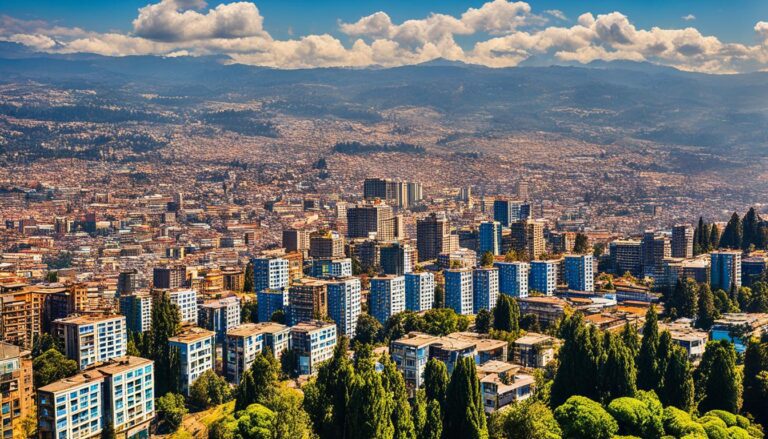What Is The Government System In Ethiopia?
Ethiopian Government System: Understanding the Political Structure of Ethiopia
Ethiopia, a country located in the Horn of Africa, operates under a federal parliamentary republic form of government. The political system of Ethiopia is based on the principles of federalism, where power is shared between the central government and regional states. The Ethiopian government system is outlined in the country’s constitution, which establishes the framework for governance, distribution of powers, and relationships between different levels of government.
The Ethiopian government is divided into three branches: the executive, legislative, and judicial branches. The executive branch is led by the Prime Minister, who is the head of government, and the President, who is the head of state. The legislative branch consists of the House of Federation and the House of Peoples’ Representatives, while the judicial branch is independent of the other two branches.
The federal structure of the Ethiopian government includes nine regional states and two chartered cities. Each regional state has its own constitution, government, and parliament, which have the power to make decisions on matters that fall within their jurisdiction. This system of decentralization allows for greater autonomy and self-governance at the regional level, while the central government retains authority over national issues.
The Ethiopian government system has evolved over time, with significant changes occurring in recent years to address various challenges and improve governance. Reforms have been introduced to enhance transparency, accountability, and inclusivity in decision-making processes. Efforts have also been made to strengthen the rule of law, promote human rights, and combat corruption within the government.
The government system in Ethiopia is characterized by a federal parliamentary republic structure that emphasizes decentralization and power-sharing between the central government and regional states. With ongoing reforms and initiatives aimed at improving governance and addressing existing challenges, Ethiopia continues to strive towards building a more democratic and inclusive political system that serves the interests of all its citizens.
Exploring the History of the Ethiopian Government System
When delving into the history of the Ethiopian government system, it becomes evident that Ethiopia has a rich and complex political heritage that dates back centuries. The traditional system of governance in Ethiopia was rooted in a monarchical structure, where the country was ruled by emperors known as “Negus” or “King of Kings.” This system prevailed for many years until significant changes occurred in the 20th century.
One of the most notable shifts in Ethiopia’s government system took place in 1974 when Emperor Haile Selassie was overthrown in a military coup. This event marked the end of the centuries-old monarchy and paved the way for the establishment of a socialist government under the Derg regime led by Mengistu Haile Mariam.
Following years of turmoil and civil unrest, Ethiopia underwent further transformations in the early 1990s. The Ethiopian People’s Revolutionary Democratic Front (EPRDF) came into power and introduced a federal system of government, aiming to address the country’s diverse ethnic composition and distribute power more equitably among its regions.
Under this federal system, Ethiopia is divided into nine ethnically-based regional states, each with its own legislative body and executive branch. This devolved structure of governance allows for a degree of autonomy at the regional level while still maintaining a central government based in the capital, Addis Ababa.
Throughout its history, the Ethiopian government system has experienced various challenges and reforms as the country grapples with issues of political stability, ethnic tensions, and democratization. Recent years have seen efforts to enhance political representation, promote human rights, and strengthen democratic institutions to ensure a more inclusive and transparent system of governance.
The evolution of the Ethiopian government system reflects a dynamic interplay between tradition and modernity, as the country navigates its path towards greater political openness, social cohesion, and economic development.
Structure of the Ethiopian Government
In Ethiopia, the government system is structured as a federal parliamentary republic. The country is officially known as the Federal Democratic Republic of Ethiopia and is divided into nine regional states and two chartered cities, including the capital, Addis Ababa. Each state has its own constitution and self-governing structure, allowing for a degree of autonomy within the federal framework.
At the federal level, the government is divided into three branches: the executive, legislative, and judicial branches. The Prime Minister is the head of government and holds the most significant executive power. He is appointed by the ruling party in the House of Peoples’ Representatives. The Prime Minister is responsible for running the government, implementing policies, and representing the country domestically and internationally.
The legislative branch in Ethiopia consists of the House of Peoples’ Representatives and the House of the Federation. The House of Peoples’ Representatives is the lower house and is the primary legislative body in the country. It is made up of representatives elected by the people through a direct vote. The House of the Federation, on the other hand, represents the regional states and ensures their interests are taken into account in the federal legislative process.
The judicial branch of the government is independent and responsible for interpreting the laws and ensuring that they are applied fairly. The Federal Supreme Court is the highest court in the country and oversees the lower courts at both the federal and regional levels. The judiciary plays a crucial role in upholding the rule of law and safeguarding the rights of citizens.
The structure of the Ethiopian government is designed to balance power between the federal and regional levels while ensuring representation and participation from all parts of the country. This system aims to promote democratic governance, protect the rights of all citizens, and facilitate the socio-economic development of Ethiopia as a whole.
The Role of the Prime Minister and President in Ethiopia
The political landscape of Ethiopia is structured around a federal parliamentary republic, where the President serves as the head of state and the Prime Minister as the head of government. Both positions hold significant power and responsibility in steering the country’s governance and policies.
The President of Ethiopia, as the head of state, serves as a ceremonial figurehead with duties that are largely symbolic and representational. The President’s role includes appointing the Prime Minister, presiding over official ceremonies, and serving as a unifying figure for the nation. However, it is essential to note that executive authority lies with the Prime Minister, who is the head of government.
On the other hand, the Prime Minister of Ethiopia is the most powerful political figure in the country, responsible for running the government and implementing policies. The Prime Minister is appointed by the President from the party or coalition that has the majority in the House of Peoples’ Representatives, the lower house of the Ethiopian Parliament.
The Prime Minister holds the authority to appoint government officials, set the national agenda, and make executive decisions on behalf of the government. This position plays a crucial role in shaping the direction of Ethiopia’s political, economic, and social development.
In recent years, Ethiopia has seen significant challenges in its government system, including issues related to ethnic tensions, human rights abuses, and political unrest. These challenges have prompted calls for reforms to address the underlying issues and create a more inclusive and transparent political system.
Efforts to reform the government system in Ethiopia have included changes to the electoral process, increased representation for marginalized groups, and reforms aimed at enhancing democratic governance. These initiatives are crucial in addressing the root causes of instability and working towards a more sustainable and inclusive political system.
The roles of the Prime Minister and President in Ethiopia play a vital part in shaping the country’s governance and future trajectory. With ongoing efforts to address challenges and implement reforms, Ethiopia is working towards a more stable, democratic, and prosperous future for its citizens.
Challenges and Reforms in the Ethiopian Government System
Ethiopia has been undergoing significant transformations in its government structure to address various challenges and implement crucial reforms. One of the key challenges faced by the Ethiopian government is related to ensuring political inclusivity and representation. Historically, Ethiopia has been characterized by a centralized and authoritarian political system, which marginalized certain ethnic groups and regions. This challenge has led to ethnic tensions and conflicts within the country.
Moreover, the Ethiopian government has faced criticism regarding issues of human rights violations and political repression. There have been instances of crackdowns on dissent, media censorship, and restrictions on political freedoms. These challenges have raised concerns both domestically and internationally about the state of democracy and human rights in Ethiopia.
In response to these challenges, the Ethiopian government has embarked on a path of reform. One of the pivotal reforms initiated by Prime Minister Abiy Ahmed is aimed at fostering political openness and inclusivity. This includes efforts to create a more democratic political environment, release political prisoners, and engage in dialogue with opposition groups.
Furthermore, the government has taken steps to promote economic reforms to address issues of poverty and unemployment in the country. Initiatives such as privatization of state-owned enterprises, liberalization of the economy, and attracting foreign investment have been introduced to stimulate economic growth and development.
Additionally, efforts have been made to enhance the rule of law and strengthen institutions to ensure accountability and transparency in governance. Reforms in the security sector, judiciary, and civil service are being pursued to build a more effective and efficient government system.
Despite these reform efforts, Ethiopia continues to face challenges such as interethnic conflicts, security threats, and economic disparities. The road to a more stable, democratic, and prosperous Ethiopia remains a work in progress, requiring sustained efforts and commitment from the government and all stakeholders involved.
The challenges and reforms in the Ethiopian government system reflect a country in transition, striving to address historical legacies, promote democratic values, and achieve sustainable development. The trajectory of Ethiopia’s political landscape will significantly impact its future trajectory and position in the global arena.
Conclusion
The government system in Ethiopia has evolved over the years, shaped by its unique history and socio-political landscape. From its historical roots to the present day structure, the Ethiopian government has undergone significant changes aimed at promoting democratic governance and inclusivity.
The history of the Ethiopian government system traces back to ancient times, with traditional monarchies giving way to different forms of governance, including communist rule and the current federal system. These transitions have been marked by political instability, civil unrest, and efforts to create a more inclusive and representative government.
The structure of the Ethiopian government is based on a federal system that empowers regional states while maintaining a centralized authority. The federal government is structured into three branches – the executive, legislative, and judicial – each with distinct roles and responsibilities in the governance of the country.
The Prime Minister and President play crucial roles in the Ethiopian government, with the Prime Minister serving as the head of government responsible for executing policies and the President serving as the head of state with ceremonial duties. Both positions wield significant influence and power in shaping the country’s direction and policies.
Challenges facing the Ethiopian government system include ethnic tensions, political unrest, and human rights violations, which have highlighted the need for meaningful reforms. Recent efforts to promote transparency, accountability, and inclusivity have shown promise in addressing these challenges and strengthening the country’s democratic institutions.
Reforms in the Ethiopian government system have focused on improving governance, enhancing political participation, and safeguarding human rights. These reforms aim to create a more inclusive and responsive government that reflects the diverse needs and aspirations of the Ethiopian people.
As Ethiopia continues on its path of reform and transformation, the government system will play a pivotal role in shaping the country’s future. By addressing the challenges and embracing meaningful reforms, Ethiopia has the potential to build a more stable, democratic, and prosperous nation that upholds the principles of justice, equality, and freedom for all its citizens.




